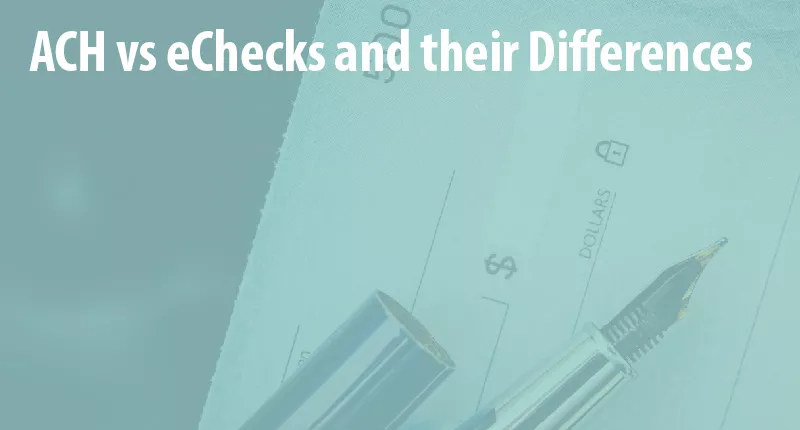
TABLE OF CONTENTS
When it comes to online payment processing, people often use the terms eCheck and ACH interchangeably. Realistically, it’s easy to think eCheck is the same as ACH transfers. Both eChecks and ACH transactions transfer funds from one bank account to another. However, there are distinct differences between ACH and eCheck transactions. As a business owner, understanding what makes them different will help you choose the bill pay process that’s best for your business. Let’s discuss eCheck vs ACH and what makes them different.
Is eCheck the Same as ACH?
Some business owners confuse ACH payments with eCheck processing and may even think the two are the same. However, the charges involved for processing eChecks and the expenses for ACH payments distinguish the two. So, if you want to know how much an eCheck costs to process you will see that eCheck vs ACH processing have different fees. Let’s look at both check processing methods before listing their differences.
What are eChecks?
Electronic checks, or eChecks, are a form of payment that initiates a bank transfer by processing a digital version of a paper check. By initiating an eCheck, you are making a one-time transfer from one bank account to another.
Processing an eCheck is much faster than manually processing a physical check. You are still using the routing and account number of the bank account and authorization from the customer when processing an eCheck. The authorization is in written form with a paper check. eChecks are processed through the ACH Network.
Here’s how eCheck processing works in four steps:

- Request authorization: As a merchant, you must get an authorization from the customer in order to complete the transaction. You can accomplish this a couple of different ways such as a phone conversation, online payment form, or signed order form.
- Payment setup: After authorization, the merchant can enter the payment information into their online payment processing software.
- Complete and submit: After correctly entering the payment information, you can complete the transaction to start the eCheck transaction process.
- Payment confirmation and funds deposit: The payment is automatically withdrawn from the customer’s bank account. Then, it’s deposited into the merchant’s bank account and the customer receives a payment receipt from the online software. The typical turnaround time for funds to get to a merchant’s bank account is 3 to 5 business days from the initiation.
Merchants will typically pay a small fee to process eCheck payments. However, they’re popular for businesses that have high-cost items or high-cost monthly fees.
ACH Processing
Also called an ACH transfer, ACH processing is a form of payment that enables merchants to send and receive payments through their online bank account. There are two types of ACH transactions. The most common is the ACH debit. These transactions are common for bill and utility payments.
Another type of ACH transfer is ACH credits. These are typically direct deposits that allow merchants to debit customers using their bank routing/ABA and account numbers once they have authorization. The processing speed and cost of ACH debits and ACH credits may vary. Typically they take between 3 to 7 days to clear.
ACH processing is ideal for merchants that have subscription-type business models where they collect recurring fees or payments from their customers.
Here is how ACH processing would work for a merchant who has an ACH account:
- Request authorization: The merchant obtains written, verbal, or electronic permission from the customer to process the payment.
- Check conversion: A payment gateway, virtual terminal, or batch file submission converts the check into an ACH transaction. Then it goes to the merchant’s payment processor.
- Payment transfer: The merchant’s check processor sends the ACH transaction to the customer’s bank. Then the approved funds are taken out of the customer’s checking account.
What Is the Difference Between eCheck and ACH Processing?

When looking at eCheck vs ACH, the main difference is the party that keeps the payment information and sends the payments. ACH transactions are processed by certain entities that use the banking information from an enrollment form to create a recurring debit from the customer’s bank account. Then, they process payments on a monthly or quarterly basis. ACH processing also automatically updates payment amounts, like when you add a tip at a restaurant.
eChecks are actually a form of ACH processing. They are based on newer technology that wasn’t available at the time that ACH processing began. An eCheck transfer uses the ACH network to process its payments. Typically, an eCheck initiates a one-time transfer from one bank account to another. This happens much faster than a physical check.
If you accept recurring payments each month, adding in the eCheck cost for payment processing will save you money over accepting paper checks and debit and credit cards. Consider the advantages. Besides providing cost savings, eChecks process quickly. However, always double-check with your merchant services provider for exact timelines.
Final Thoughts
As you can see, eCheck and ACH processing are more similar than they are different. In both types of transactions, you need to have the customer’s authorization to debit their bank account for compliance purposes.
An eCheck cost for processing allows you to increase sales while greatly reducing the chance of fraud. That’s because an eCheck features the latest protections in data and processing. These features include detection of duplicate processing, digital signature authentication, encryption, and public-key cryptography.
Moreover, eChecks are better than paper checks when it comes to environmental emissions. The use of eChecks reduces about 3.5 million tons of greenhouse gas annually, all of which comes from transporting paper checks. If you’re deciding between eCheck vs ACH, an online payment processor can help you decide what’s best for your business.





